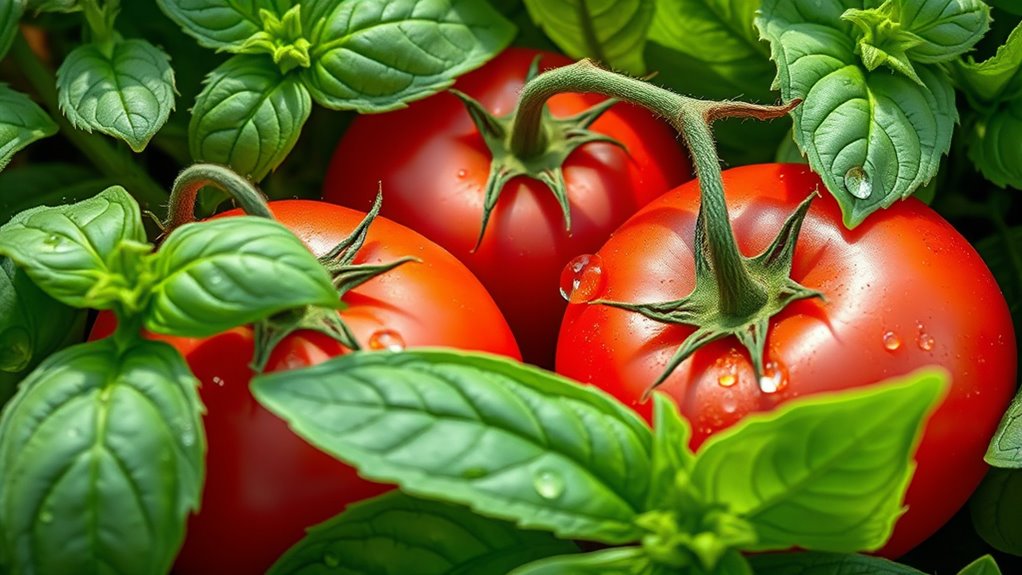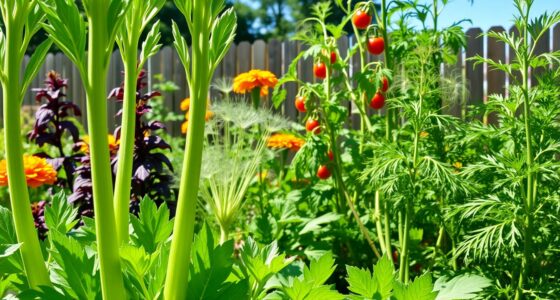Planting tomatoes and basil together creates a natural, beneficial partnership in your garden. Basil boosts tomato growth, improves flavor, and helps repel pests like aphids and whiteflies, reducing your need for chemicals. Both plants thrive in similar conditions and benefit from being about 12 inches apart. As they grow, basil’s fragrant leaves further protect your tomatoes and add beauty to your garden. Keep exploring to discover more tips for making this duo thrive.
Key Takeaways
- Companion planting with basil enhances tomato flavor and promotes healthier growth through natural synergy.
- Basil repels common tomato pests like aphids and whiteflies, reducing the need for chemical pesticides.
- Both plants share similar soil and water needs, making them easy to care for together.
- Growing basil near tomatoes attracts beneficial insects and supports a resilient garden ecosystem.
- The aromatic basil foliage adds visual appeal and natural pest deterrence to your garden space.

Have you ever noticed how perfectly tomatoes and basil complement each other in both flavor and appearance? This pairing isn’t just about delicious salads or pasta dishes; it’s a classic example of companion planting that benefits your garden in practical ways. When you plant basil alongside tomatoes, you create a natural synergy that boosts growth and health for both plants. Basil acts as a companion plant, enhancing the flavor of your tomatoes and making the garden more vibrant and productive. But beyond flavor and aesthetics, basil also plays a critical role in pest control. It helps repel common tomato pests like aphids, whiteflies, and spider mites, reducing the need for chemical interventions. By planting basil nearby, you’re fundamentally giving your garden a built-in pest barrier, which keeps your tomatoes healthier and reduces the risk of infestations.
The benefits of this duo extend beyond pest control. Basil’s presence can improve the overall growth and yield of your tomato plants. The two plants share similar soil and water requirements, making them easy to care for together. Plus, basil’s fragrant leaves can mask the scent of your tomatoes, confusing pests that rely on smell to locate their hosts. This natural pest-repellent property means fewer bugs biting into your fruits and fewer worries about disease transmission. The practice of companion planting with basil and tomatoes is rooted in traditional gardening wisdom, but modern science supports these benefits, showing how certain plant combinations can create a more resilient garden ecosystem.
Planting basil close to your tomatoes is straightforward. Simply space them about 12 inches apart, ensuring each plant has enough room to grow and access sunlight. Basil’s quick growth means you’ll notice its benefits early in the season, and it’s easy to harvest fresh leaves for your culinary needs. As basil matures, its scent intensifies, further deterring pests and attracting beneficial insects like pollinators. This natural pest control reduces your reliance on pesticides, making your garden safer for pollinators, pets, and your family. Plus, the attractive green foliage of basil adds visual interest and a fresh aroma to your garden beds, creating a more inviting space.
Frequently Asked Questions
Can Basil Help Repel Tomato Pests Naturally?
You might wonder if basil can naturally repel tomato pests. While basil is known as a natural pest repellent, its effectiveness varies. By planting basil nearby, you can use organic gardening techniques to deter pests like aphids and whiteflies. This method promotes a healthier garden without chemicals. Incorporating basil into your garden not only enhances flavor but also supports sustainable pest management naturally.
What Are the Best Companion Plants for Tomatoes and Basil?
Did you know that companion planting can increase crop yields by up to 50%? For tomatoes and basil, consider planting marigolds for pest prevention, as they repel nematodes and aphids. Nasturtiums also attract pests away from your main crops. These companion plants support healthy growth, naturally deter pests, and create a thriving garden ecosystem—making your garden more productive and resilient without relying on chemicals.
How Do I Prevent Basil From Flowering Too Early?
To prevent basil from flowering too early, focus on proper pruning techniques. Regularly pinch off flower buds to encourage leafy growth and delay flowering. Make certain your basil gets adequate sunlight, typically 6-8 hours daily, as sufficient sunlight helps suppress premature flowering. Also, avoid over-fertilizing with high-nitrogen fertilizers, which can promote flowering. By maintaining consistent pruning and providing the right sunlight, you’ll enjoy lush, flavorful basil for longer.
What Watering Schedule Promotes Optimal Growth for Both?
Imagine your garden as a delicate dance where water keeps the rhythm. You should water your plants when the top inch of soil feels dry, usually every 2-3 days. This watering frequency helps maintain moisture retention without overdoing it. Consistent watering keeps both tomatoes and basil thriving, preventing stress and promoting lush growth. Adjust based on weather, ensuring your garden stays hydrated and vibrant, like a well-orchestrated symphony.
Are There Specific Soil Amendments Beneficial for These Plants?
You should consider adding compost amendments to improve soil fertility and structure, helping your plants grow strong. Additionally, pH balancing is essential to guarantee nutrients are available; aim for a slightly acidic to neutral pH. Regularly testing your soil allows you to adjust with amendments as needed. These steps create an ideal environment for healthy root development and vigorous growth, ensuring your garden thrives.
Conclusion
Just like a symphony comes alive with every instrument, your garden thrives when tomatoes and basil grow together. Their partnership isn’t just about flavor; it’s about creating a vibrant, easy-to-maintain duo that enhances your space and your meals. When you plant these two side by side, you’re nurturing a simple yet powerful connection—one that turns your garden into a lush, delicious paradise. Embrace this perfect pairing and watch your garden blossom with flavor and life.









